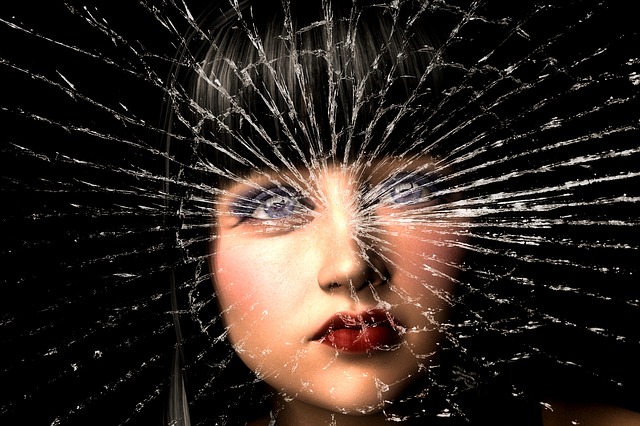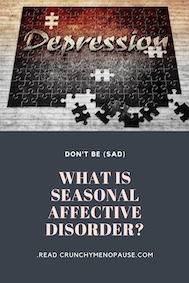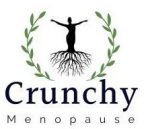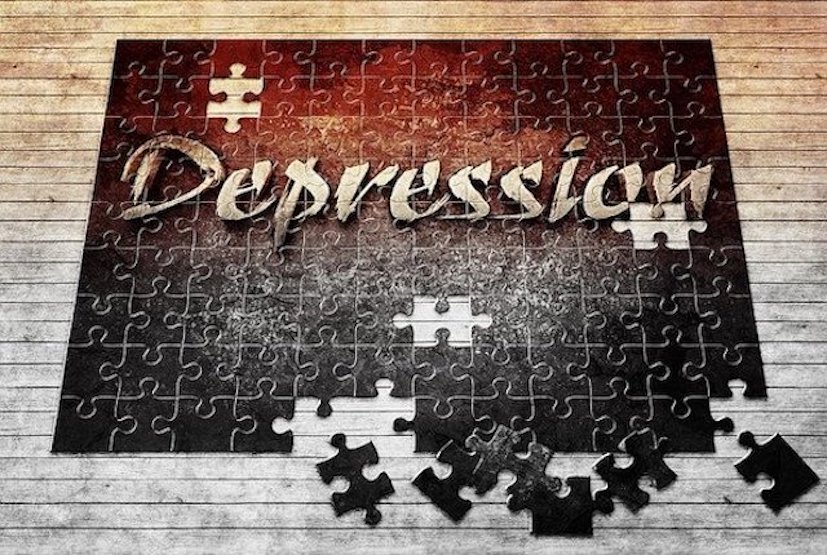Otherwise known as SAD, Seasonal Affective Disorder is the winter blues.
Every year about the same time, usually fall and winter, a person can become depressed. It can vary from mild to extreme and become debilitating at times.
SAD is something scientists have not done a lot of research on and the jury is still out on what exactly is happening and what actually causes it.
There are theories as to what causes it, but only that. They don’t know for sure.
I was surprised to find out that the answer to my questIon: What is Seasonal Affective Disorder? was not cut and dry, but actually quite complicated and diverse.
There have actually been research papers written that state there is no such thing as SAD. I didn’t want that to set a precedent, because obviously, there is such a thing because people I know are affected by it.
Just because research cannot prove something, doesn’t mean it doesn’t exist. I think of many examples, like Fibromyalgia and Lyme disease to name a few.
My mother was told she had Fibromyalgia, but not all doctors agree that there is such a thing.
I have close family members who suffer from SAD, so I wanted to do more research on their behalf. I am in no way qualified to give medical advice, but that isn’t what this article is meant to be.
I just wanted to do some research and record what I found.
Please don’t take anything I say here as a substitute for getting help. Do your own research and go to the doctor if you need help.
This blog post is about finding answers and presenting them in layman’s terms so I can wrap my head around what is happening to those I love. It is also for others who may suffer in silence every winter because they don’t know about SAD.
WHAT DOES SCIENCE SAY?

Seasonal Affective Disorder usually happens in the fall and winter. However, I was surprised to find out there is another kind that affects people in the summer.
As the seasons change, so does your mood.
This is interesting to me because the common denominator seems to be the sun. When it doesn’t shine as brightly, some individuals get depressed.
According to Clinical Phycological Science, Seasonal Affective Disorder is not supported by subjective data. Instead, they suggest it has roots in folk psychology.
Well, here at Crunchy Menopause, we are all about folk psychology. Let me tell you that there are many old-time folk remedies that actually work, therefore there can also be things that don’t quite make sense in the science world.
That doesn’t mean it doesn’t exist.
A patient health survey was distributed to U.S residents in regards to SAD, which resulted in determining sunlight has no effect on major depression. Crazy, right?
However, according to the National Center for Biotechnology Information, SAD affects those who live farthest from the equator in northern latitudes.
So, my question is this? Why wasn’t the survey sent out to Canadian residents?
I live in northwestern Canada and I can tell you the days get dark and dreary here, and most certainly affect a person’s mood.
Temperatures usually dip well below minus 40 Celsius which is the same as minus 40 in Ferenheight. The better part of the winter is frigid cold which keeps people inside. Though I haven’t read a study linking cold weather to SAD, it might be a possibility.
Knowing that the research disputing SAD was done in the U.S, I tend to dismiss the findings. Why don’t they survey those who live in far northern latitudes and consider those results?
Until then, all we can do is watch, listen, and learn from those around us. If someone says they feel sad only at certain times of the year, believe them and help them seek medical advice.
WHAT DOES IT FEEL LIKE?

I see how SAD affects my close loved ones. They seem very sluggish during low sun-times.
It’s almost as if their body is telling them to hibernate. They sleep long and can’t get up easily.
Motivation is always lacking.
That’s not all. Some become angry and moody during SAD periods. If they already struggle with other forms of mental illness like Bipolar, or ADHD, it can become severe.
People with Rapid Cycle Bipolar struggle with mania instead of depression more often during SAD times. That is hard to understand for those who aren’t familiar with the effects of bipolar, but its part of the manic episodes so often contributed to the mental illness.
I have a close family member who has RCBP, and I can tell you winter months are the hardest part of the year because of SAD.
In those cases, it’s important to make sure your loved one has not skipped any medications. Most bipolar people take a plethora of medications, and now is not the time to forget them or suddenly stop taking them.
SAD is lurking in the background during winter months. It has to be understood that bipolar symptoms can get much worse in combination with Seasonal Affective Disorder. Any mental illness can become much worse during the winter and needs to be monitored by a professional.
If you don’t have an underlying mental illness, you still have to be wary.
SAD can be mild or severe. According to NCBI, the mild form is called S-SAD. A person can feel depressed when it’s cloudy. This usually only affects them during the winter months.
Some say they don’t have a lot of motivation and can’t get moving especially in the morning. They just want to sleep.
Seasonal Affective Disorder can make a person moody, angry, depressed, or suicidal in extreme cases. Those who have loved ones with severe SAD, need to monitor them closely and make sure they get the professional help they need.
MEDICAL TREATMENT

Not all depressive symptoms warrant medication. The best way to determine if you or a loved one needs medication is to go to the doctor to get evaluated.
Discuss what you’re feeling with your doctor. If your depression lasts for longer than two weeks, generally you need it evaluated by a doctor. Seasonal depression comes and goes, but major depression is chronic and you want to make sure it’s not that.
The difference between mild and severe SAD is how long it lasts and how you feel. For the most part, everyone has days when they feel down and depressed.
Feeling sad about things that don’t work out, or a situation you can’t control, is normal. It’s the body’s way of coping. Coping with life is painful, but necessary.
We will always face hard times but If we mask that pain or try to avoid it, we will never get through the problem. It’s important to allow yourself to feel the pain. It means you’re dealing with it.
Sometimes being sad is okay as long as you don’t stay there.
People with major depression can’t get out of their sadness without medications like mood stabilizer drugs. People with SAD have difficulty getting out of it on their own, depending on the severity.
If you’re wondering if you have SAD, or your loved one has it, there is a test your doctor can give you to see if you fall within the perimeters of SAD. It’s called The Seasonal Pattern Assessment Questionnaire (SPAQ) and it’s a self-assessment test, free to download from the Public Domain. No training is required to use this test. I’ll link it at the end of this article in the resource section.
Sometimes it isn’t SAD at all.
Sometimes it’s situational depression. When the difficulty you’re experiencing suddenly ends, your depression ends. For the most part, that’s just about everyone on the planet as long as you don’t get stuck there.
However, I am not downplaying anything. All forms of depression are real and problematic.
NATURAL REMEDIES

Trying natural remedies for depression is risky.
Self-medication is not something you or your loved one should play around with especially if its major depression. Seek medical advice immediately if you or your loved one is experiencing thoughts of suicide or self-harm.
However, in mild depressive cases, natural remedies have been known to help.
According to NCBI, people with S-SAD, the mild version of Seasonal Affective Disorder, have found relief with things like light therapy, physical exercise, and therapy.
The National Center of Biological Information has stated that group therapy sessions are just as effective as medication for mild SAD in some cases.
I will link all the medical research papers at the end of this article for reference so you can find out for yourself. It’s important to educate yourself so you can help a friend or loved one seek the right kind of help.
Help can be a combination of medications and natural remedies. It can also be one or the other. It all depends on the severity of Seasonal Affective Disorder and the person who has it. If someone refuses treatment, there is nothing you can do.
But you can be supportive.
If the person affected with SAD only wants natural remedies, then be supportive and try to help. There is nothing wrong with natural ways to cope with depression as long as it isn’t life-threatening.
I am an advocate for natural health, but only in the right situations.
Going forward, many studies have shown that vitamin D helps with SAD. You naturally get vitamin D from the sun. The NCBI says they have found that people with SAD generally have low levels of vitamin D. That makes sense considering SAD happens in the winter.
Coincidentally, people with red hair generate their own vitamin D. I am a natural-born redhead and I don’t suffer from SAD or major depression.
Sometimes I get sad because of a certain situation, but I usually bounce right back, even in the winter months. I can clearly see that vitamin D could play a huge factor in SAD.
However, some health gurus say you shouldn’t supplement with vitamin D at all. They claim it’s an artificial hormone and can play havoc with your body. They say supplementing with vitamin D creates a whole new set of problems.
I don’t know what to believe, so I won’t form a judgment. You will have to do your own research. All I know is that the best place to get vitamin D is from the sun’s rays.
Every day at noon, go outside in the winter months even if it’s just for a half-hour. Sunbathe in your winter jacket. On sunny days it can be quite warm. Soak up the vitamin D through the natural rays of the sun.
I’ve also heard that salt lamps can help with SAD. Studies suggest that these lamps can boost mood and improve energy levels, increasing serotonin in the brain. You can check them out through the following Amazon affiliate link, LEVOIT Kana Salt Lamp, and see what you think.
According to NCBI, people with SAD have lower serotonin and increased melatonin during winter months which interrupts the body’s natural rhythm. Salt lamps may correct that.
Lightboxes or light therapy may also prove effective for people with SAD. You can check them out through the following Amazon affiliate link, Light Therapy Lamp, and see what you think. They seem to help even though they give off artificial sunlight. There may be some side effects though, so be sure to check with a doctor.
According to NCBI, people who take a winter vacation to a sunny destination struggle less with SAD symptoms. That gives you a great reason to get away every winter.
Motivational speakers help as well. Anything that encourages a person will help improve symptoms of Seasonal Affective Disorder. There are a lot of podcasts available to listen to for free. They will give you endless hours of motivation.
Also, it’s important to socialize even if SAD makes you feel like you don’t want to. Social activity helps maintain good mental health.
Finally, according to a PubMed article, there has been research done on the effects of magnesium therapy on major depression. They have discovered that with 125-300 mg of magnesium at every meal and at bedtime, documented recovery of major depression can happen in as little as 7 days.
That is a great way to fight SAD.
Personally, I have been taking Magnesium now for many years. You can check out the kind I use by following the Amazon affiliate link, CanPrev Bis-Glycinate for more information.
You can also read about how magnesium has helped me by going to the following link, How Magnesium Changed My Life if you’re interested in reading more about my personal experience with it.
CONCLUSION
In conclusion, I just wanted to say that depression is no joke. It doesn’t matter what kind you suffer from; you need to be vigilant and evaluate your symptoms.
If it’s something you think might be dangerous or chronic, seek medical attention immediately. If you are worried about a loved one who may be depressed, support them and communicate with them.
You might save a life.
If you suffer from a mild form of depression and want to seek natural ways to feel better, make sure you check into it thoroughly. There are naturopathic doctors who can help with this as well.
The bottom line is, you are not alone!
This article was created for informational purposes only. It is not meant to be a substitute for medical help in any way. Crunchy Menopause is not responsible (in any way) for anyone who may or may not follow the suggestions in this article.
Please do your own research and seek medical attention immediately if you have suicidal thoughts or feelings of self-harm.
Be well!
RESEARCH ARTICLES USED FOR THIS ARTICLE
- Mayo Clinic
- Center for Addiction and Mental Health
- NCBI
- National Institute of Mental Health
- Scientific American (Study Disputing SAD)
- Health and Consumers
- Center for Environmental Therapeutics
- Lighting Newswire
- Healthline
- PubMed (Magnesium Study)
- Seasonal Pattern Assessment Questionnaire (SPAQ)
PLEASE CONSIDER PINNING THIS ON PINTEREST. THANK YOU!

_____________________________________________________

Author Kathleen Morris
Kathleen Morris is a successful published author, blogger, and Youtuber. She enjoys writing about things she’s passionate about and making a difference in the world.

